Gardening Calendar for June
June is a busy month in the gardening calendar. The weather is warm and sunny, and your plants are growing vigorously. It's the perfect time to enjoy your garden and tackle any essential tasks that need to be done. Here's a complete gardening calendar for June that will guide you through all the essential tasks and events that you need to know.
1. Planting Vegetables
June is a great month to plant your summer vegetables. Sow seeds of beans, corn, cucumbers, pumpkins, squash, and tomatoes directly into the soil. You can also transplant seedlings of peppers, eggplants, and melons that you started indoors earlier.
2. Watering
June is also a crucial month for watering your plants. Water them deeply and less frequently to encourage deep root growth. Water early in the morning or late in the evening to minimize evaporation.

3. Mulching
June is a good month to add a layer of mulch to your garden beds. This will help retain moisture and suppress weeds. Use organic materials like straw, grass clippings, or shredded leaves.
4. Lawn Care
June is also a crucial month for lawn care. Mow your lawn regularly and keep it at a height of around 2.5-3 inches. Water it deeply and less frequently, and fertilize it with a slow-release fertilizer.
5. Pruning
June is a good time to prune your shrubs and trees. Remove any dead, damaged, or diseased branches, and shape the plant according to your desired form.
6. Harvesting
June is the month when you can start harvesting some of your crops. Pick lettuce, spinach, and other leafy greens when they are young and tender. Also, harvest strawberries, raspberries, and blueberries when they are ripe and ready.
7. Pest Control
June is also the month when pests and diseases start to emerge. Keep an eye out for aphids, slugs, and snails, and treat them with organic or chemical insecticides as needed. Also, keep your garden clean and free of debris to prevent fungal diseases.
8. Flower Beds
June is the month when your flower beds are in full bloom. Deadhead faded flowers to encourage new blooms, and remove any dead or diseased plants. Add a layer of mulch to retain moisture and suppress weeds.
9. Soil Testing
June is an excellent time to test your soil for pH and nutrient levels. You can buy a soil testing kit from your local garden centre or send a soil sample to a laboratory for analysis.
By following this gardening calendar for June, you can ensure that your garden stays healthy, productive, and beautiful throughout the growing season. Happy gardening!
FAQs
-
What vegetables can I plant in June? You can plant a wide range of vegetables in June, including beans, corn, cucumbers, pumpkins, squash, and tomatoes. You can also transplant seedlings of peppers, eggplants, and melons that you started indoors earlier.
-
How often should I water my plants in June? Water your plants deeply and less frequently to encourage deep root growth. Water early in the morning or late in the evening to minimize evaporation.
-
How do I control pests and diseases in my garden in June? Keep your garden clean and free of debris to prevent fungal diseases. Treat pests and diseases with organic or chemical insecticides as needed.
-
When should I harvest my crops in June? You can start harvesting some of your crops in June, such as lettuce, spinach, strawberries, raspberries, and blueberries, when they are ripe and ready.
-
How do I prune my shrubs and trees in June? Remove any dead, damaged, or diseased branches, and shape the plant according to your desired form. Make sure to use sharp and clean tools to prevent the spread of disease.
-
How do I deadhead flowers in June? Deadhead faded flowers by pinching or cutting off the stem just below the flower head. This will encourage new blooms and prevent the plant from wasting energy on seed production.
-
In conclusion, June is a critical month in the gardening calendar, as it marks the height of the growing season. By planting your summer vegetables, watering your plants deeply, mulching your garden beds, taking care of your lawn, pruning your shrubs and trees, harvesting your crops, controlling pests and diseases, deadheading your flowers, and testing your soil, you can ensure that your garden stays healthy, productive, and beautiful throughout the year. Happy gardening!
-
How do I test my soil in June? You can buy a soil testing kit from your local garden centre or send a soil sample to a laboratory for analysis. Make sure to follow the instructions carefully and take samples from different areas of your garden.
-
How do I fertilize my lawn in June? Fertilize your lawn with a slow-release fertilizer to promote healthy growth. Follow the instructions on the package carefully and apply it evenly across your lawn.
-
How do I prevent evaporation when watering my plants in June? Water early in the morning or late in the evening to minimize evaporation. Use a watering can or a hose with a nozzle to apply water directly to the soil.
June is a critical month in the gardening calendar, as it marks the height of the growing season. By planting your summer vegetables, watering your plants deeply, mulching your garden beds, taking care of your lawn, pruning your shrubs and trees, harvesting your crops, controlling pests and diseases, deadheading your flowers, and testing your soil, you can ensure that your garden stays healthy, productive, and beautiful throughout the year. Happy gardening!
